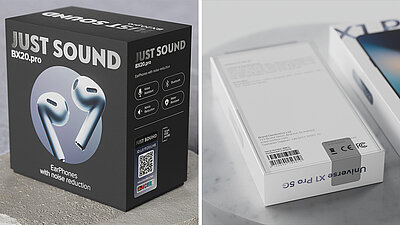Counterfeiting and cosmetics: A significant problem for consumers

The market
As of early 2022, the global cosmetics industry was estimated to be worth around $600 billion USD. This encompassed a wide range of products, including skincare, haircare, makeup, fragrances, toiletries, and more. The industry has experienced steady growth over the years, driven by factors such as increasing consumer demand, innovation in product formulations, expanding beauty markets in emerging economies, and the influence of social media and beauty influencers.
Counterfeiting in the cosmetics market
However, this steady growth has also led to a dramatic increase in counterfeiting in this market. It is estimated that cosmetics companies lose about 4.7 billion Euros or 5.16 USD each year to counterfeiting. Counterfeit cosmetics refer to imitation or fake products that are manufactured to replicate the appearance of genuine cosmetics. Counterfeiters often replicate packaging, labels, and branding materials to closely resemble authentic products. They might use similar logos, colors, and typography to deceive consumers.
Counterfeiting in the cosmetics industry spans a wide range of products and brands, with counterfeiters replicating popular and high-demand items. Some examples of counterfeit cosmetics include:
- Fake Makeup Products: Counterfeiters reproduce popular makeup items such as foundation, lipstick, eyeshadow palettes, and mascara. These fake products often mimic the packaging, colors, and branding of well-known cosmetic lines, deceiving consumers into believing they're purchasing authentic items.
- Counterfeit Skincare Products: Counterfeiters replicate skincare products like serums, moisturizers, and anti-aging creams. These fake items may contain substandard or harmful ingredients, posing potential risks to consumers' skin health.
- Counterfeit Perfumes and Fragrances: Counterfeiters produce fake versions of perfumes and colognes from recognized fragrance brands. These counterfeit fragrances imitate the scent and packaging of the original products but often lack the quality and safety standards of genuine items.
- Counterfeit Haircare Products: Shampoos, conditioners, hair treatments, and styling products are also counterfeited. Fake versions of these products may contain harmful substances or lack the intended benefits of genuine formulations.
A prominent brand that has been dealing with huge counterfeiting issues is the well-known make-up brand Kylie Cosmetics. To save money, fans of the make-up brand had begun purchasing the products on Amazon or eBay. However, they were met with alarming results after using the products. In one instance, a woman’s lips swelled after using a counterfeit gloss, and another said it made her lips stick together. Some counterfeit lip kits by the brand even contained feces. This prompted the owner of the brand Kylie Kardashian to publish a statement to her fans not to buy her products anywhere else than on her official website.
Especially in this market, counterfeiting poses several significant issues. Here are some key problems:
For consumers:
- Consumer health risks: Counterfeit cosmetics often contain harmful ingredients such as lead, arsenic, mercury, and other toxic substances. These substances can cause severe allergic reactions, skin irritation, and in some cases, long-term health issues or damage.
- Quality: Counterfeit cosmetics typically lack the quality standards and efficacy of genuine products. They may not deliver the promised results and might even cause adverse effects due to substandard ingredients or improper formulations.
- Healthcare Costs: Health issues arising from counterfeit cosmetics can lead to increased healthcare expenses for affected consumers.
For brands and the cosmetics market in general:
- Brand Reputation: Counterfeiting damages the reputation of cosmetic brands. Consumers who unknowingly purchase fake products and experience negative effects might associate those issues with the authentic brand, leading to a loss of trust and credibility.
- Economic Impact: Some reports and industry estimates suggest that the global cosmetics industry loses billions of dollars annually due to counterfeit products. Companies invest in research, development, and quality control, but counterfeiters benefit unfairly by producing cheaper, lower-quality imitations.
First steps to tackle the issue
To start tackling this issue, governments have added a few pointers for cosmetics in their track and trace regulations. However, these add-ons are by far not enough yet to have any significant effect on decreasing counterfeiting activity.
Track and trace regulations aim to enhance supply chain transparency, traceability, and consumer safety by implementing systems that track the movement of products from manufacturing to the point of sale.
The European Union
The European Union (EU) has implemented track and trace regulations to enhance the safety and authenticity of products, including cosmetics, across its member states. One of the key initiatives in this regard is the EU's Falsified Medicines Directive (FMD), which includes provisions for the verification of prescription medicines, as well as certain measures applicable to cosmetic products.
Furthermore, the EU Cosmetics Regulation (EC) No 1223/2009 outlines requirements for product information, labeling, and safety assessment. It emphasizes the responsibility of manufacturers and importers to ensure the traceability of cosmetic products in the EU market.
The EU Cosmetics Regulation mandates that cosmetic products must be labeled with specific information, including:
- Product Information File (PIF): Manufacturers must maintain a PIF containing details about the product's safety assessment, composition, manufacturing method, and more.
- Labeling Requirements: Cosmetic products sold in the EU must have labels with information such as ingredients, warnings, batch numbers, and contact details of the responsible person or entity.
- Reporting: Manufacturers or importers must report cosmetic products placed on the EU market to the Cosmetic Products Notification Portal (CPNP).
The United States
Even though the United States has the biggest cosmetics market in the world, it does not have specific federal track and trace regulations dedicated to cosmetics - unlike the stringent track and trace requirements for pharmaceuticals. The U.S Food and Drug Administration (FDA) regulates cosmetics under the Federal Food, Drug, and Cosmetic Act (FD&C Act) and imposes certain labeling and manufacturing requirements to ensure product safety and consumer information.
While track and trace measures have proven effective in some industries, such as pharmaceuticals, implementing these measures for cosmetics hasn't solved the issue of counterfeiting. Several reasons contribute to the continued challenge of combating counterfeit cosmetics despite track and trace efforts:
- Complex Supply Chains: The cosmetics industry often involves intricate global supply chains with numerous suppliers, manufacturers, distributors, and retailers.
- Costs and Implementation: Developing and implementing effective track and trace systems for cosmetics can be costly for manufacturers, particularly for smaller companies or those with limited resources. The expenses involved in incorporating sophisticated technologies, databases, and infrastructure might hinder widespread adoption, especially for smaller or less-established brands.
- Regulatory Variation: Cosmetics regulations differ across regions and countries. The lack of uniformity in regulations and track and trace standards globally can create loopholes that counterfeiters exploit. This lack of harmonization limits the effectiveness of track and trace measures, especially when counterfeit products can easily enter markets with weaker regulatory oversight.
- Online Marketplaces and Illicit Channels: The rise of e-commerce and online marketplaces has made it easier for counterfeiters to sell their products anonymously. Illicit channels, including unregulated online platforms and unauthorized retailers, make it difficult to monitor and control the distribution of counterfeit cosmetics.
- Consumer Awareness and Behavior: Despite track and trace measures, some consumers may unknowingly purchase counterfeit cosmetics due to lack of awareness, opting for cheaper alternatives, or buying from unauthorized sources.
Furthermore, a track and trace system focuses on product traceability instead of product authentication. Although they can aid in identifying the legitimate origins of a product, they are unable to verify the authenticity of individual cosmetic products. Therefore, it is possible for counterfeiters to create convincing replicas that bypass detection within the track and trace system.
Moreover, the track and trace technology typically relies on the tracking of distinct codes or serial numbers that are associated with the products. The counterfeiters can easily reproduce these codes or alter packaging to simulate an authentic product. This makes it very difficult for customers to distinguish between genuine and counterfeit packaging.
Therefore to address the counterfeiting issue in the cosmetics market bigger steps have to be taken in future. Strengthening regulations, raising awareness about the risks of counterfeit products, implementing better authentication methods, and taking legal actions against counterfeiters are steps that can help mitigate the problem of counterfeiting in the cosmetics industry.
SCRIBOS is your partner against counterfeiting in the cosmetics industry
As we have outlined, it is ineffective to solely have a track and trace system in place to tackle the counterfeiting issue in the cosmetics market. Instead, it is important to have a security tag on the product, that cannot be copied, removed or tampered with. Also, this security tag should be easily authenticated by your customer.
We have wide variety of solutions that fulfill these requirements:
Our security labels are manufactured using innovative and proprietary technologies, which offer maximum protection against counterfeiting. All of our labels are 100% serialised and combine overt, semi-overt and covert features for easy authentication by all target groups. Over the past 20 years, there has been no successful imitation attempt of our labels.

Tamper-proof seals
Security seals prevent unauthorised opening and refilling by clearly indicating prior opening by displaying an irreversible void effect. This first-opening effect remains visible even if an attempt is made to reseal the tamper-evident seal. The design, including the opening effect, can be changed to match your packaging design and corporate identity. We also have it available in a sustainable paper version.

Printed security
ValiGate® is a simple, scalable, and sustainable brand protection solution, which can be printed directly onto your cosmetics packaging or onto a label. Without the costly use of random patterns or fingerprint technology, ValiGate® can be integrated into a QR code. This embedded, patented security pattern cannot be copied nor re-engineered and therefore provides a forgery-proof, serialised, and scalable counterfeit protection for high product volumes.
Consumers can easily and reliably authenticate products and detect counterfeits and grey market goods. No app is required for the authentication process. By linking each ValiGate® to our digital platform, every scan is turned into actionable data for brand owners to remove fakes from the market and gain back market shares from counterfeiters. On top of this, it opens avenues for customer interaction, track and trace and market analysis.

Another perfect solution for the cosmetics industry is our brand-new security label ZOOM, which integrates our proven ValiGate® technology into the market-leading holographic products of KURZ. This makes it the first holographic security element that can be authenticated by anyone with a smart phone. No adapter, no app, and no training is needed.
This combination offers numerous advantages, as it combines digital and optical security into a single solution. Furthermore, this solution can be seamlessly integrated into the workflows of print shops equipped with hot stamping capabilities. However, it can also be ordered as a finished label.

Digital Platform SCRIBOS 360
All of the brand protection technology are connected to the innovative digital cloud platform SCRIBOS 360. Our digital platform includes a fast and intuitive online authentication module for all consumers, logins for brand experts with an overview of all scans and statistics, a grey-market detection and alert module, and more.
Check out all the different modules our digital platform offers here
Together with our brand protection experts, we will find the perfect solution for your cosmetics product. Start protecting your products now!




